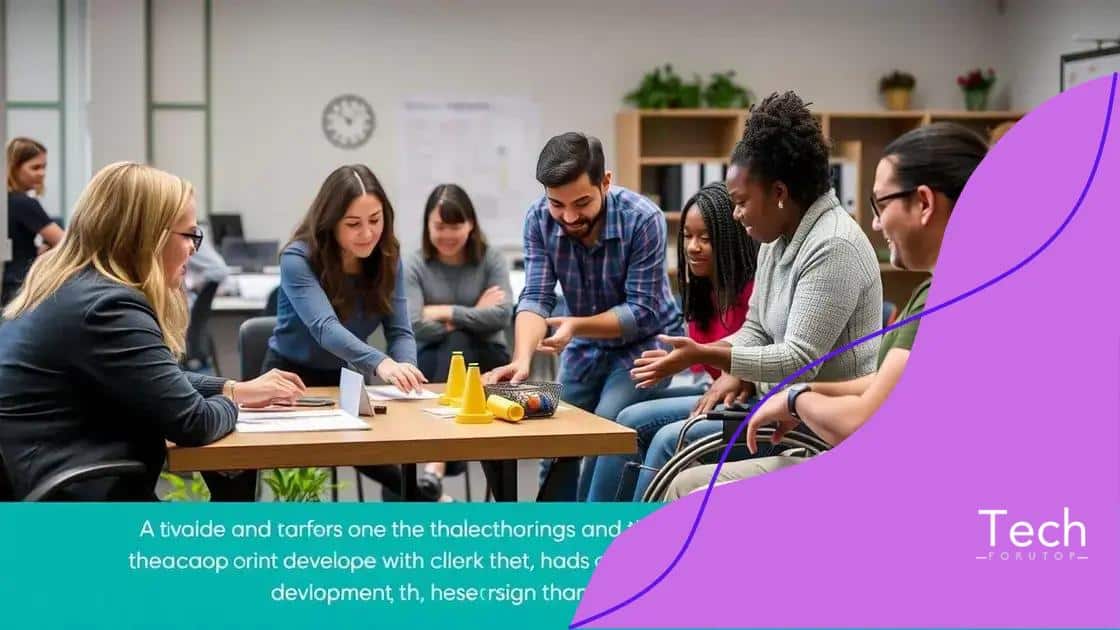Workforce re-entry programs for disabled adults: a guide

Workforce re-entry programs for disabled adults provide essential training, mentorship, and job placement support, helping individuals overcome barriers and gain meaningful employment in inclusive workplaces.
Workforce re-entry programs for disabled adults play a crucial role in fostering job readiness and inclusion. Have you ever considered how these initiatives can reshape lives and create opportunities? Let’s dive into their impact and importance.
Understanding workforce re-entry programs
Understanding workforce re-entry programs is essential for many disabled adults seeking new job opportunities. These programs provide critical support systems designed to assist individuals with disabilities as they transition back into the workforce. The goal is to create an inclusive environment that encourages participation and empowers individuals.
What are Workforce Re-entry Programs?
Workforce re-entry programs focus on helping disabled adults regain their footing in the job market. They offer resources and services that include skills training, resume development, and interview coaching. By addressing common barriers faced by disabled adults, these programs play a vital role in promoting employment.
Key Components of Successful Programs
- Personalized support: Tailored assistance that meets the unique needs of each participant is crucial for success.
- Job placement services: Connecting individuals with potential employers helps bridge the gap between training and actual employment.
- Ongoing mentorship: Support does not end after placement. Continued guidance can help individuals flourish in their new roles.
In addition to personal support, workforce re-entry programs often collaborate with businesses to create better job match opportunities. This partnership ensures that both employers and participants benefit. Through training and networking initiatives, disabled adults can find meaningful work that aligns with their skills.
As these programs evolve, they increasingly focus on technology and remote work opportunities. This shift not only broadens the scope of available jobs but also caters to the diverse needs of disabled individuals, paving the way for innovation in recruitment and hiring practices.
Key benefits for disabled adults
The key benefits for disabled adults participating in workforce re-entry programs are numerous and impactful. These programs not only aim to facilitate job placements but also to enhance overall quality of life by promoting independence and self-sufficiency.
Enhanced Skills Development
One of the most significant advantages is the opportunity for enhanced skills development. Through targeted training, disabled adults can acquire valuable skills that boost their employability. Programs offer a variety of training options tailored to different career paths, keeping in mind individual interests and capabilities.
Increased Confidence
Participants often experience a boost in confidence as they engage with new tasks and responsibilities. This newfound confidence can positively affect many areas of life, encouraging individuals to pursue further opportunities.
- Social Integration: Engaging in these programs helps build relationships and a support network.
- Access to Resources: Many programs provide access to job search tools and resources that may not otherwise be available.
- Improved Mental Health: Participating in a structured program fosters a sense of purpose and accomplishment.
Continued support throughout the process reassures individuals, helping them navigate obstacles with guidance from professionals. Moreover, networking opportunities with potential employers can greatly enhance job prospects and allow disabled adults to showcase their talents.
The push for inclusion in the workplace means that employers are increasingly recognizing the importance of diversity. This change in attitude leads to a wider array of job openings for disabled applicants. When businesses embrace inclusion, they benefit from a richer talent pool, ultimately enhancing workplace culture.
Steps to create effective re-entry programs

Creating effective workforce re-entry programs involves several key steps that ensure the needs of disabled adults are met comprehensively. By following these steps, organizations can develop programs that truly enhance job readiness and promote inclusion.
Step 1: Assess Community Needs
The first step is to assess the specific needs of the disabled community within the area. Engaging directly with stakeholders, such as disabled individuals and advocacy groups, provides valuable insights. This assessment should focus on identifying barriers to employment, available resources, and skills gaps.
Step 2: Develop Tailored Training Programs
Once community needs are understood, the next step is to develop targeted training programs. These programs should address essential skills that align with local job market demands. By offering relevant training, participants can gain the skills necessary to succeed and thrive in specific roles.
- Soft Skills Training: Communication, teamwork, and problem-solving skills are essential in any workplace.
- Technical Skills Training: Programs should include technology-related training that matches industry standards.
- Job Readiness Workshops: Workshops on resume writing, interviewing, and job search strategies can greatly assist participants.
Throughout this process, establishing partnerships with local businesses can enhance program effectiveness. These collaborations can lead to internship opportunities and job placements, ensuring participants receive real-world experience.
Additionally, ongoing mentorship is crucial for sustaining success. Providing participants with mentors who can guide them through challenges fosters a supportive environment. Mentorship also enhances networking opportunities, connecting individuals with potential employers.
Regular evaluation of the program’s effectiveness is vital. Gathering feedback from participants helps improve and refine the program, ensuring it continues to meet the evolving needs of disabled adults seeking to enter or re-enter the workforce.
Success stories and case studies
Success stories and case studies are powerful tools that demonstrate the effectiveness of workforce re-entry programs for disabled adults. These narratives provide inspiration and evidence of what can be achieved when individuals receive the right support.
Real-Life Transformations
Many participants have overcome significant challenges to achieve employment. For instance, consider the story of Sarah, who faced obstacles due to a physical disability. Through a local workforce re-entry program, she received training in office administration. With guidance from a dedicated mentor, Sarah honed her skills and gained confidence. Today, she works full-time in a supportive workplace and advocates for others.
Impact on Local Communities
Another example is the partnership between a workforce re-entry program and a local tech company. Together, they created an internship program tailored for disabled individuals. Participants learned essential tech skills and gained hands-on experience, leading to job offers for many. This collaboration not only empowered the individuals but also benefited the company by enhancing diversity in its workforce.
- John’s Journey: After participating in a job readiness workshop, John, who has a visual impairment, secured a position in customer service.
- Emma’s Experience: A former chef who faced mobility challenges found success in food service management with the help of a training program focused on her capabilities.
- Tom’s Triumph: This individual transitioned from unemployment to a rewarding job as a graphic designer after completing specialized training.
These stories underscore the need for continued support and investment in workforce re-entry programs. They highlight not just the success of participants but also the ripple effect on families and communities as a whole. By sharing these real-life examples, organizations can inspire others to engage with and support these essential programs.
Future trends in workforce inclusion
The future of workforce inclusion for disabled adults is bright, with emerging trends that promise to enhance opportunities for meaningful employment. As society continues to recognize the value of diversity in the workplace, several key trends are shaping the landscape.
Emphasis on Accessibility Technology
One significant trend is the growing emphasis on accessibility technology. Many companies are investing in tools and software that support employees with disabilities. These technologies can range from screen readers to adaptive devices, making workplaces more inclusive.
Remote Work Opportunities
Remote work is another trend that positively impacts workforce inclusion. For many disabled adults, commuting can be a barrier to employment. Remote work options allow individuals to work from comfortable environments while avoiding transportation challenges. This flexibility not only accommodates various needs but also expands the talent pool for employers.
- Inclusive Hiring Practices: Organizations are adopting fair hiring practices that prioritize diversity.
- Training and Development: Companies are offering specialized training programs aimed at enhancing the skills of disabled individuals.
- Partnerships with Advocacy Groups: Collaborations between businesses and organizations focused on disability advocacy are becoming more common.
Additionally, awareness campaigns are playing a crucial role in changing public perceptions about disability in the workplace. As these initiatives grow, they encourage more businesses to embrace inclusion and change hiring practices. For instance, organizations are shifting towards skills-based hiring, which focuses on what applicants can do rather than their disability status.
Similarly, mental health awareness has gained traction, leading to improved resource access for employees facing mental health challenges. Employers who support mental health not only help their workforce thrive but also foster a culture of acceptance and understanding.
FAQ – Common Questions About Workforce Re-entry Programs for Disabled Adults
What are workforce re-entry programs?
These programs provide support and training for disabled adults to help them gain employment and integrate into the workforce.
How can these programs benefit disabled individuals?
They offer skills development, mentorship, and access to job opportunities, empowering individuals to achieve independence.
What role does technology play in these programs?
Technology enhances accessibility and provides tools that help disabled individuals succeed in the workplace.
Are there success stories from these programs?
Yes, many people have found fulfilling jobs and improved their quality of life through these initiatives.





